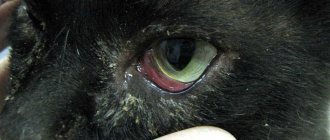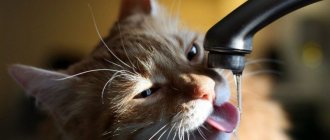Cats are distinguished by their ability to see in the dark. This is not surprising, because mustachioed pets are predators by nature. Unfortunately, eye pathologies are common in these pets. Certain eye diseases in cats lead to partial loss of vision or blindness. If you do not sound the alarm in time and contact a veterinarian, the animal may lose the ability to see. One of the main symptoms of this condition is cloudy eyes in a cat. Below we will analyze the causes of this phenomenon, and also determine possible treatment methods.
Causes of the disease
The main causes of blurred vision in a cat include:
- Diseases of the eye cornea. It loses its shine, becomes whitish, and a bluish tint appears.
- Diseases of the lens. Such pathologies are characterized by clouding of the pupil, the cornea remains transparent and is not affected. When the light is pointed at the organ of vision, the haze narrows. This confirms that the reason lies precisely in the pupil.
Below we will look at the origin of the loss of transparency of the animal's eye in more detail.
Relevance of the problem
If a cat's eye becomes cloudy, it appears as if he is blind. But it is not always the case. To determine the true cause of blurred vision in a pet, you need to contact a veterinarian-ophthalmologist.
The fact is that the causes of this eye pathology can be various diseases: cataracts, keratitis, glaucoma, uveitis. They can only be recognized in a veterinary clinic using special equipment.
Keratitis
With this disease, vision always becomes worse, sometimes completely lost. The disease appears due to toxic damage to the liver. Most often this occurs during intoxication and poisoning, during acute infectious pathologies of the organs of vision caused by pathogenic microorganisms, fungi, viruses or neurogenic diseases.
To stop your cat's vision loss, immediate veterinary attention is needed.
Symptoms
The first sign of keratitis is a cloudy red eye in a cat. Initially, redness and discharge of purulent or serous fluid appear. Then the cornea loses transparency, the eye becomes cloudy, and ulcers or tissue necrosis appear.
An accurate diagnosis is necessary to select the appropriate treatment. It is carried out using a special fluorescent liquid composition. After this, damage to the cornea becomes visible in the light. This type of diagnosis is carried out only in a veterinary clinic.
Treatment of keratitis
Treatment at home is strictly contraindicated. Keratitis is a polyetiological disease; without establishing the exact cause, self-therapy can be harmful.
After diagnostics and diagnosis, the specialist prescribes treatment aimed at eliminating the consequences of the identified eye pathology and maintaining the cat’s immunity.
Antiseptic drugs for washing the organ of vision, as well as antiviral and antibacterial ointments and drops, are necessarily prescribed. In addition, you should pay attention to your pet’s diet. It must be complete and contain a sufficient amount of microelements and vitamins.
Glaucoma
This eye disease in animals develops against the background of increased intraocular pressure. During an acute attack of pathology, the cornea ceases to be transparent, and the symptom of a cloudy eye appears in a cat.
Optic atrophy can cause a pet to completely lose vision within two to four days. Therefore, the cat needs emergency veterinary care.
Diagnostics
To choose the right treatment, it is necessary to make an accurate diagnosis. To do this, the following diagnostic measures are carried out:
- Schirmer's test. During the procedure, special paper is used. It is applied to the corner of the organ and the degree of wetting is observed. In this way, it is possible to determine the level of tear fluid.
- Use of ultraviolet lamps. The technique makes it possible to identify erosions and ulcers.
- Tonometry. By measuring intraocular pressure, it is possible to detect glaucoma already at the initial stage of development.
- Complete serological blood test. The study is carried out to identify infections.
- Activities aimed at identifying leukemia, toxoplasmosis, infectious peritonitis, immunodeficiency.
Additionally, the following studies are performed:
- corneal scraping;
- serology;
- Ultrasound;
- vitreous sample;
- tests to determine sensitivity to medications;
- detection of herpesvirus;
- electroretinography.
Corneal ulcers and erosions
These corneal diseases vary in depth and can occur due to chemical, thermal and mechanical injuries, as well as chlamydia, glaucoma, inflammatory eye pathologies and other diseases. The distinctive features of this disease are:
- redness of the cornea of the organ of vision;
- fear of light;
- clouding of the eye.
The owner in this situation may notice that the cat’s one eye has become cloudy, while the other is fine.
Characteristic symptoms
Doctors distinguish several degrees of damage to the organ of vision:
- peripheral (a border is observed at the edges of the eyeball);
- central (clouding of the eye is noted in the very center);
- total (the cat’s organ of vision is completely closed).
In most cases, if a kitten has a cloudy eye, there will be accompanying symptoms.
Against the background of decreased vision, the pet begins to walk unsteadily and does not notice obstacles . He becomes irritable and overly excitable. Strabismus, pain, swelling, and the appearance of discharge are possible.
If the cornea is affected, there is clouding of the surface of the eye. It acquires a blue or white tint and loses its shine.
Sometimes the lens is affected, but the cornea continues to remain transparent, and only the pupil becomes cloudy. Under the influence of bright light, a narrowing of the turbidity is observed, and when exposed to dim light, it expands.
Scar (thorn) of the cornea
This defect causes clouding of the cornea after burns, trauma or ulcers. There are several types of disease:
- A peripheral cataract, it does not have a significant harmful effect on vision, since it is located away from the pupil.
- A total cataract covers the cornea and pupil. With this pathology, vision is significantly reduced.
- Central thorn. Located on the pupil itself. It can cover it completely or partially. Vision becomes limited.
The disease is characterized by a cloudy spot on the cat's eye. For treatment, special ointments and drops are used, which can only be prescribed by a veterinarian.
Why does the eye become cloudy?
The appearance of a whitish film or clouding of the cornea is largely associated with the pathology of the third eyelid. This is a thin light film in the corner of the cat's eye that protects the mucous membrane from foreign bodies. The third eyelid produces a small amount of tear secretion, which helps get rid of dirt and dust.
If a cat has a cloudy spot on its eye, this is a good reason for concern. In addition to problems with the third eyelid, problems with clouding of the cornea or lens can be caused by the following reasons. Let's list them:
- Mechanical damage. A bruise, a scratch after a fight, the ingress of dust or dirt will lead to clouding of one eye of the cat, the ingress of chemicals (including human shampoo).
- Problem with eyeball fluid. The reasons can be different - infectious diseases, metabolic disorders, abuse and misuse of medications or food poisoning.
- Cataracts and various forms of conjunctivitis.
- Genetic predisposition . British and Persian breeds are susceptible to such a disease as entropion.
- Development of fungi, viruses and dangerous microorganisms.
- The appearance of ulcers on the corneas . A common cause of clouding of the eye or lens depends on the age of the cat. Appears due to chemical influences and poisoning.
- Critical accumulation of lipids in corneal tissue. The main reason is metabolic disorders.
- Cancer disease. The saddest version of events, which often leads to the death of a pet. Treatment can only prolong the cat's stay in the family.
- Postoperative problems . If the cat is old, there is a high probability that surgical intervention will lead to a difficult rehabilitation period. If, after visiting a veterinary clinic, a cloudy spot appears on your cat’s eye, you should immediately contact your doctor.
As we can see, there are a large number of reasons why a cat’s eyes are cloudy.
In most cases, the exact cause can only be determined by a specialist with the proper equipment.
ATTENTION! Many experts are inclined to believe that a cloudy pupil or clouding of the cornea of the eye appears due to autoimmune diseases. In a broad sense, defense mechanisms attack and destroy their own cells for various reasons.
In addition to the obvious clouding of the pupil, the disease is accompanied by the following unpleasant symptoms:
- The cat is afraid of light and often closes its eyes. There may be lacrimation and an abundance of pus.
- The cat becomes irritable and spends a lot of time hiding in a secluded place.
- The eyeball enlarges, the eyes literally protrude, and blood vessels burst.
- The cat sleeps little and loses its appetite. He even refuses his favorite food.
Let us also note three main diseases that are in one way or another associated with clouding of the lens.
Glaucoma
The disease is associated with increased intraocular pressure, and a possible change in the size of the organ. Vision noticeably deteriorates, coordination of movements is impaired. The eye may become completely cloudy or completely white.
Nocturnal lifestyle is simply not possible. The cat bumps into objects. Glaucoma can affect both eyes. An animal, especially a kitten, needs immediate help. The deadline lasts for days, otherwise the pet will lose its sight completely.
Keratitis
In a general sense, the disease is characterized as a lesion of the cornea. It is with keratitis that complete clouding of the eye is observed. The disease spreads gradually, but if it is started, it will soon affect the entire organ. The cause can be infectious diseases and even mechanical injuries.
The ingress of foreign objects should not be excluded. The likelihood of developing keratitis increases with age. This may be poorly treated conjunctivitis or ulcers on the cornea.
Cataract
A cataract, in fact, is a clouding of the pupil. The disease can progress and lead to complete loss of vision. The cause of cataracts may be metabolic disorders or previous infectious diseases.
Causes of clouding and damage to the lens
The pupil of the eye itself does not lose transparency, since it is a hole in the iris. The transparent biolens of the organ of vision, called the lens, becomes cloudy. It is located behind the pupil.
The main cause of clouding is considered to be cataracts. This pathology manifests itself for several reasons:
- changes in metabolism associated with the age of the animal (old individuals);
- endocrine diseases - lipid metabolism disorders, diabetes mellitus;
- pupil injuries;
- infectious pathologies in a pregnant individual can cause pathology of the eye lens in a kitten;
- Certain breeds of cats have a genetic predisposition to this disease: Persians, Burmese, Siamese.
Treatment of cataracts, carried out with the help of medications, can only temporarily slow down the development of the disease.
Therapy
Radical treatment for lens opacity involves replacing it with surgery. If radical treatment is not carried out in time, the process will develop further with severe complications:
- uveitis – inflammation of the uvea of the eye, often leading to blindness;
- secondary glaucoma with optic nerve atrophy and vision loss;
- panophthalmitis - the release of masses of the lens into the chambers of the eye, the appearance of inflammation, pus: all this leads to the death of the eye.
It becomes clear that if a cat's eye is covered with a cloudy film, this can lead to partial loss of vision or complete blindness. Restoring the function of the organ of vision depends on how quickly the animal owner contacted the veterinarian. In addition, a correct diagnosis and quality treatment are important. Positive results most often appear in cases where the pathology is detected at an early stage of development.
The cat's eyes hurt: we treat ailments correctly
page » Cats » Diseases and treatment of cats » The cat has sore eyes: we treat illnesses correctly
Everyone knows that cats have excellent vision, but eye diseases can significantly impair its sharpness. There are plenty of reasons for problems with the visual apparatus in animals. Sometimes the quality of vision deteriorates due to the development of retinal atrophy.
As a rule, this disease occurs in cases where the cat has to live in a poorly lit room. In addition, cats' vision also weakens with age.
Photos will help you promptly recognize eye diseases in cats - we suggest you find out the symptoms and treatment of these ailments in our article.
One of the common types of eye diseases in cats is conjunctivitis. It can be catarrhal, follicular, parenchymal, purulent. It can also occur in both acute and chronic forms. In order to start treatment on time, it is necessary to pay attention to alarming symptoms that may indicate serious problems with your pet’s health.
If the cat is not treated appropriately, the disease becomes chronic.
| Photo | Form of the disease | Symptoms | Treatment |
| Acute conjunctivitis |
|
| |
| Catarrhal conjunctivitis |
|
| |
| Parenchymal conjunctivitis |
|
| |
| Purulent conjunctivitis |
|
| |
| Follicular conjunctivitis | The most severe form of this disease, which is characterized by the following symptoms: photophobia;
|
|
Keratitis
Depending on the degree of complexity of the disease, keratitis can be superficial, ulcerative and parenchymal. The occurrence of this disease can be caused by a cut, damage to the eyelid or scratch. If your beloved pet begins to frequently rub its eye with its paw, you should show it to the veterinarian. In the photo below you can see the first signs of keratitis.
| Symptoms | Treatment |
|
|
Cataract
A characteristic feature of this disease is a clouded lens of the eye. Cataracts come in several types: toxic, congenital, symptomatic, layered, nuclear, complete, capsular.
The presence of this disease contributes to weakening of the cat’s vision. The cause of this disease in cats is inflammation of the cornea or an infectious disease.
The photo clearly shows what a cataract looks like.
| Symptoms | Treatment |
|
|
The listed eye diseases in cats should not be ignored. To avoid their serious complications, appropriate measures must be taken to eliminate the pathology.
Prevention
In order to prevent clouding of your cat’s eyes, you should follow a few simple rules for keeping your pet:
- Vaccinate the animal against infectious pathologies in a timely manner;
- undergo timely examinations by a specialist;
- Consult a doctor immediately after identifying unpleasant eye pathologies.
It should be borne in mind that if the cat already has inflammation of the organs of vision, the animal must be closely monitored. Your pet should be examined at least twice a day. If severe inflammation, redness, or clouding of the cornea appears, you should immediately go to the veterinarian. To prevent the condition from worsening, all stress factors for the animal should be kept to a minimum. Since they are the ones who can provoke a deterioration in the animal’s condition. The owner must also take into account the fact that from the room where the sick cat is located, it is necessary to remove interior items that the cat could hit and suffer.
It should also be understood that any eye pathology can lead to loss of vision in a cat, so you should not leave even the most harmless inflammation of the mucous membrane uncontrolled.
In addition, the owner must provide the sick animal with complete rest and, if possible, include foods with a high concentration of tocopherol and retinol in the cat’s diet. These vitamins have a positive effect on damaged epithelial layers of the cornea and restore the organs of vision.











